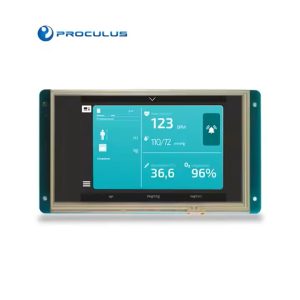How does LCD work? Understanding its components and benefits
Knowing how LCD works is essential for understanding its role in modern display technology.
LCDs utilize liquid crystals to control light transmission, enabling sharp, energy-efficient visuals across a wide range of applications.
From consumer electronics to industrial control systems, this technology has revolutionized how we interact with digital content.
By exploring its core components and functionality, you can better appreciate the advantages and innovations driving LCD displays forward.
 Beyond contrast ratio and response time, additional techniques can further refine an LCD’s performance, delivering sharper visuals and smoother motion.
Beyond contrast ratio and response time, additional techniques can further refine an LCD’s performance, delivering sharper visuals and smoother motion.

What is LCD?
A Liquid Crystal Display (LCD) is a flat-panel display technology that utilizes liquid crystals to manipulate light and render images. Unlike traditional cathode ray tube (CRT) displays, LCDs are thinner, lighter, and consume significantly less power, making them the preferred choice for a wide range of applications, from smartphones and medical devices to industrial control systems.How do LCD Displays Work?
Liquid crystal displays (LCDs) operate by manipulating light through liquid crystal materials. Each pixel in an LCD consists of a light source, typically an LED, and a thin layer of liquid crystals. By applying an electric current, the liquid crystals can be aligned to either block or transmit light from the backlight, allowing the display to render images.How Liquid Crystals Work?
Liquid crystals exist in a mesophase state, having properties between conventional liquids and solids. They flow like liquids but maintain a degree of molecular order. The rod-shaped liquid crystal molecules can be aligned by applying an electric field, which allows them to control light transmission. Optimizing two key factors, contrast and response time, significantly enhances an LCD’s performance. Contrast refers to the difference in luminance between the darkest and brightest areas of the LCD screen module. Higher contrast produces brighter whites and darker blacks, resulting in a sharper, more vivid image. Response time indicates how quickly the liquid crystals can change alignment, which impacts motion blur and ghosting. Faster response times translate to smoother video and gameplay experiences. With ongoing innovation, LCD technology continues to advance, bringing higher performance, better image quality, and an ever more immersive viewing experience.How to improve the contrast ratio of an LCD?
To enhance an LCD display’s contrast ratio, developers can implement a few methods, like:Backlight Adjustment
Adjusting the display’s backlight can have a significant impact on contrast. Increasing backlight intensity will improve contrast, allowing the display to produce deeper blacks and brighter whites. However, higher backlight settings can reduce display lifespan and increase power consumption. This is an important factor when it comes to energy-efficient designs.Local Dimming
Some LCD displays utilize local dimming, where the backlight intensity is varied in different areas of the screen. This allows dark areas of an image to remain dim while bright areas are illuminated. Local dimming can provide up to a 50% improvement in contrast ratio versus a non-dimming backlight.High Dynamic Range(HDR)
High Dynamic Range or HDR is a technique where the display supports a wider range of luminance levels. By increasing the range between the deepest black and brightest white the display can produce, HDR can double the standard contrast ratio. HDR-capable displays require HDR content and graphics cards to leverage the increased range.Panel Bit Depth
Increasing the bit depth of the LCD panel itself, from traditional 6-bit (262,000 colors) up to 10-bit (1.07 billion colors) or higher, provides more available shades for the display to produce. However, higher bit panels tend to cost significantly more. This becomes an important consideration while balancing budget and performance. By implementing one or more of these methods, LCD contrast ratio and display clarity can be substantially improved. The optimal solution will depend on your specific requirements, display usage, power and cost constraints.Reducing LCD response time: techniques for faster refresh rates
Response time refers to the speed at which pixels in an LCD panel can change from one color to another. Faster response times mean less motion blur and ghosting, which can improve the viewing experience for applications like gaming or video editing.Other tips to enhance LCD performance
 Beyond contrast ratio and response time, additional techniques can further refine an LCD’s performance, delivering sharper visuals and smoother motion.
Beyond contrast ratio and response time, additional techniques can further refine an LCD’s performance, delivering sharper visuals and smoother motion.
Overclocking the display
LCD panel modules are capable of operating at refresh rates higher than their default. This is known as “overclocking” and can be enabled through the display’s on-screen menu. A higher refresh rate means the screen redraws the image more frequently, which can improve response times and make motion appear smoother. However, overclocking a display may reduce its lifespan or introduce image artifacts, so use this technique cautiously, and as per the manufacturer’s specifications.Reducing pixel switching time
The time required for a pixel to change from one color to another, measured in milliseconds (ms), determines an LCD’s response time. Panels with lower pixel switching times, such as 1ms to 5ms, tend to have faster response rates and less motion blur. Some gaming monitors promote response times of 1ms or less for optimal performance. Faster pixel switching can be achieved through the use of higher quality display components and optimized pixel driving technologies.
Display strobing
Some advanced monitors offer optional strobing backlight features. These techniques strobe the backlight in sync with the refresh rate to minimize the time pixels spend transitioning, which can significantly improve motion clarity and reduce ghosting. However, strobing the backlight can reduce the overall brightness of the display and may cause eye strain for some users. This feature often cannot be used simultaneously with variable refresh rate technologies. Using a combination of these techniques, LCD response times and refresh rates can be enhanced for a better viewing experience with less motion blur and improved clarity for on-screen movement. Optimizing your display’s settings and choosing a high-performance monitor designed for gaming or video editing are effective ways to unlock its full potential.Unlock the Full Potential of LCD Technology with Proculus’ Custom Solutions
At Proculus Technologies, we specialize in high-performance, custom LCD display integration solutions designed to meet the unique demands of your application. Whether you need seamless integration, enhanced visual performance, or a user-friendly interface, our UART TFT LCD modules provide the perfect balance of innovation, efficiency, and reliability. From industrial automation to consumer electronics, our displays are engineered for optimal clarity, responsiveness, and long-term durability. With easy-to-use software tools and expert support, we help you accelerate development, reduce costs, and enhance user experience. Explore our solutions today! Discover how Proculus’ LCD modules can elevate your product’s performance. Learn more here.Conclusion
LCD technology continues to evolve, offering sharper visuals, faster response times, and more efficient performance. By implementing advanced techniques, such as local dimming, HDR, overclocking, and pixel optimization, you can unlock superior display quality tailored to your specific needs. With Proculus Technologies, you don’t just get an LCD module integration—you get a cutting-edge display solution designed for seamless integration and exceptional performance. Whether you’re developing an industrial interface, a medical device, or a next-gen consumer product, our custom solutions empower you to bring your vision to life. Ready to optimize your display technology? Get started today.
Category:
Author:
Client:
Date:
Related products
PHP Code Snippets Powered By : XYZScripts.com
 English
English


